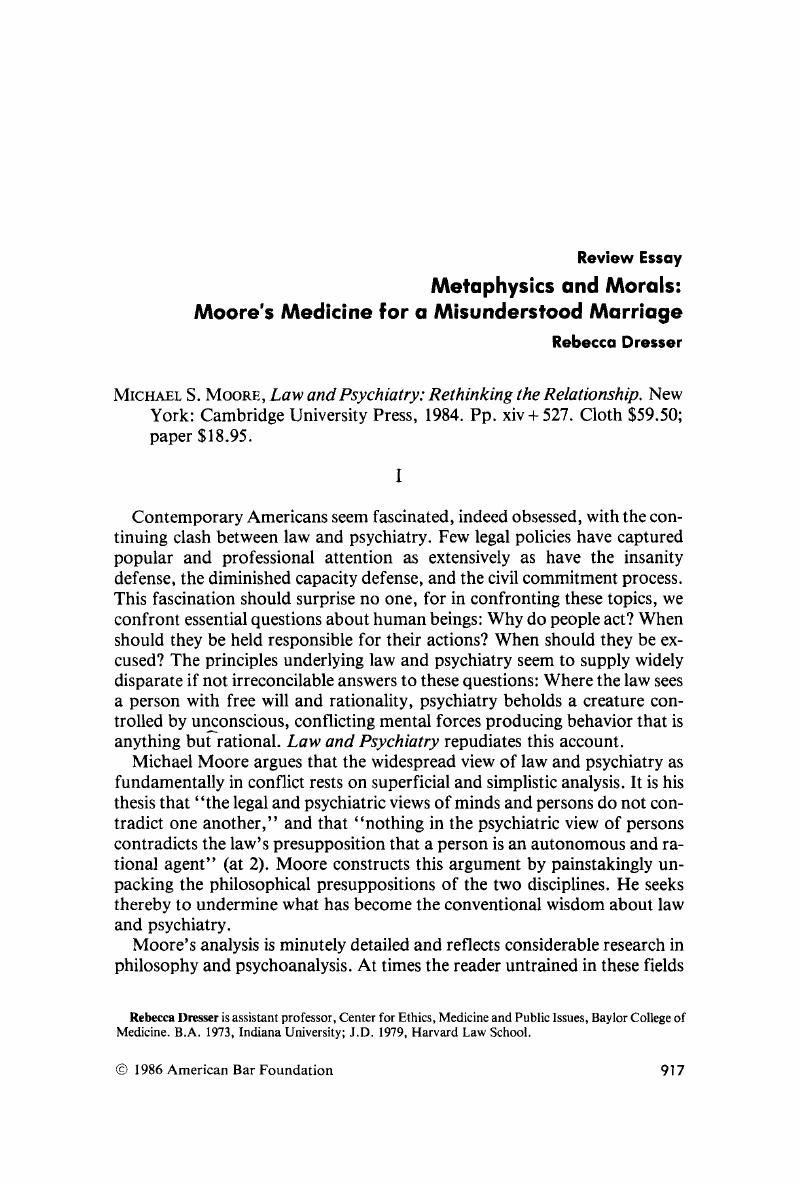No CrossRef data available.
Published online by Cambridge University Press: 20 November 2018

1 Moore's emphasis is on Freudian theory, apparently because he views Freud's work as superior to other approaches in constructing a general psychological theory of human behavior (at 419).Google Scholar
2 Moore cites Aristotle as the originator of these ideas on practical reasoning (at 13).Google Scholar
3 In mental cause explanations, desires and beliefs cause actions but fail to rationalize them (at 15–18).Google Scholar
4 Hermeneutic interpretations focus on desires and beliefs that rationalize actions for observers without attempting to ascertain whether those mental states constituted the actor's real motive (at 18–22).Google Scholar
5 Functional attributions are composed of four elements: system, end state, process, and effect. In functional explanations, an end state is caused by an effect of a process (at 26–27). This form of explanation differs from reason-giving accounts in its failure both to address the actor's state of mind and to rationalize his actions (at 30).Google Scholar
6 In mechanistic explanations, causes of behavior are not mental states but instead are, e.g., physical or environmental factors (at 32–36).Google Scholar
7 Moore assumes that law and morality have at least contingent identity, i.e., that laws and legal concepts depend on the existence of corresponding moral rules and concepts (at 48–49).Google Scholar
8 Some philosophers would disagree with this argument. See, e.g., Tom Regan, The Case for Animal Rights (Berkeley: University of California Press, 1983).Google Scholar
9 Thomas Szasz and others argue that mental illness is a myth. Moore separates this argument into the following claims: “that there is no such thing as mental illness, that those we call mentally ill are fully as rational as anyone else, only with different aims, that the only reason anyone ever thought differently was because of unsophisticated category mistakes or because of his adherence to the epistemology of a sick society, and that the phrase accordingly is only a mask used to disguise moral judgments in pseudoscientific respectability” (at 180). See Szasz, Thomas, The Myth of Mental Illness (New York: Harper & Row, 1961).Google Scholar
10 Moore admits the need to explore further the specific degree of irrationality necessary, as well as the precise mental capacities that must be impaired, for an individual to qualify as mentally ill under this definition (at 215–16).Google Scholar
11 As Moore notes, this test has three essential elements: “first, that one suffer from a defect of reason; second, that such defect stem from a disease of the mind; and third, that one lack knowledge of some kind, either the knowledge of what one is doing or the moral knowledge that what one is doing is wrong” (at 219).Google Scholar
12 This test excuses those mentally ill individuals who lack the ability to control their behavior. Id.Google Scholar
13 Most notably, the American Law Institute definition adopted in many jurisdictions (at 219–20).Google Scholar
14 According to this rule, a defendant is not responsible if the criminal act was the product of a mental disease or defect. Durham v. United States, 214 F.2d 862 (D.C. Cir. 1954).Google Scholar
15 See supra notes 4 and 6 and accompanying text.Google Scholar
16 Moore observes that this is a more attenuated sense of responsibility than that assigned to persons for their positive actions. Further, he believes Freud might have contemplated responsibility only in the negligent omission sense when he discussed responsibility for actions based on finconscious beliefs and desires (at 343–48).Google Scholar
17 Moore points out a “conceptual schizophrenia” in psychoanalysis, in which clinicians employ the language of intention and responsibility in therapy with their patients, while theoreticians speak of behavior in mechanistic, nonintentional terms (at 381–83).Google Scholar
18 See Perry, John, The Problem of Personal Identity, in John Perry, ed., Personal Identity 3, 15 (Berkeley: University of California Press, 1975).Google Scholar
19 Parfit, Derek, Later Selves and Moral Principles, in Alan Montefiore, ed., Philosophy and Personal Relations 137, 140 (Montreal: McGill-Queen's University Press, 1973).CrossRefGoogle Scholar
20 Id. at 139–40; Derek Parfit, Reasons and Persons 204–6 (Oxford: Oxford University Press, 1984).Google Scholar
21 Parfit, supra note 20, at 205–6.Google Scholar
22 Id.Google Scholar
23 Parfit, supra note 19, at 140–42.Google Scholar
24 Parfit, supra note 20, at 319–20. see also Regan, Donald, Paternalism, Freedom, Identity, and Commitment, in Rolf Sartorius, ed., Paternalism 113–38 (Minneapolis: University of Minnesota Press, 1983).Google Scholar
25 See Parfit, , supra note 20, at 322–29.Google Scholar
26 Living wills are documents individuals may sign to assert that they do not wish to receive treatment that would serve only to postpone “artificially” the moment of death. See, e.g., Ill. Ann. Stat. ch. 110.5, § 701 (Smith-Hurd 1984).Google Scholar
27 See President's Commission for the Study of Ethical Problems in Medicine and Biomedical and Behavioral Research, Deciding to Forego Life-Sustaining Treatment 136–48 (Washington, D.C.: Government Printing Office, 1983).Google Scholar
28 See Dresser, Rebeccca, Bound to Treatment: The Ulysses Contract, Hastings Center Report, June 1984, at 13.Google Scholar
29 I discuss these issues in greater detail in Advance Directives, Self-Determination, and Personal Identity, in Chris Hackler, Ray Moseley, & Dorle Vawter, eds., Advance Directives in Medicine (in press).Google Scholar